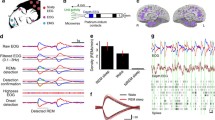Summary
Eye and head position, EEG, and activity of oculomotor and vestibular neurons in the brain-stem were recorded during alertness and at the transition to light sleep. Characteristic changes of firing patterns were found in many neuronal populations at the sleep-wake transition and could be related to disruption of fixation and rapid and compensatory eye movement generation. Moto-neurons decreased their firing rate by 20 to 50%, and their eye velocity coding deteriorated. Burst neurons had a significant drop in maximum firing rates and often showed continuous activity unrelated to rapid eye movements, but responded to vestibular stimuli. Pause neurons went completely silent. Neurons in the vestibular nuclei often reduced their level of activity, but still responded qualitatively unchanged to semicircular canal stimulation. In the framework of current models of oculomotor organization, the sleep-wake transition can be interpreted as a non-equilibrium phase transition which is driven by specific inputs and nonspecific activating systems.
Similar content being viewed by others
References
Bert J, Pegram V, Rhodes JM, Balzano E, Naquet R (1970) A comparative sleep study of two cercopithecinae. Electroencephalogr Clin Neurophysiol 28: 32–40
Berthoz A, Vidal PP, Corvisier J (1982) Brain stem neurons mediating horizontal eye position signals to dorsal neck muscles of the alert cat. In: Roucoux A, Crommelinck M (eds) Physiological and pathological aspects of eye movements. Junk, The Hague, pp 385–398
Bizzi E, Pompeiano O, Somogyi (1964) Spontaneous activity of single vestibular neurons of unrestrained cats during sleep and wakefulness. Arch Ital Biol 102: 308–330
Collins WE (1962) Effects of mental set upon vestibular nystagmus. J Exp Psychol 63: 191–197
Dodge R (1903) Five types of eye movement in the horizontal meridian plane of the field of regard. Am J Physiol 8: 307–329
Eckmiller R, Mackeben M (1976) Functional changes in the oculomotor system of the monkey at various stages of barbiturate anesthesia and alertness. Pflügers Arch 363: 33–42
Evinger LC, Fuchs AF, Baker R (1977) Bilateral lesions of the medial longitudinal fasciculus in monkeys: effects on the horizontal and vertical components of voluntary and vestibular induced eye movements. Exp Brain Res 28: 1–20
Hepp K, Henn V, Jaeger J (1982) Eye movement related neurons in the cerebellar nuclei of the alert monkey. Exp Brain Res 45: 253–261
Hepp K, Henn V (1983) Spatio-temporal recoding of rapid eye movement signals in the monkey paramedian pontine reticular formation (PPRF). Exp Brain Res 52: 105–120
Hepp K, Henn V (1983) Neurodynamics of the oculomotor system: space-time recoding and a non-equilibrium phase transition. Springer Series in Synergetics. Springer, Berlin Heidelberg New York, in press
Hobson JA, Scheibel AB (1980) The brainstem core: sensorimotor integration and behavioral state control. Neurosci Res Prog Bull 18: 1–173
Keller EL (1980) Oculomotor specificity within subdivisions of the brain stem reticular formation. In: Hobson JA, Brazier MAB (eds) The reticular formation revisited. Raven Press, New York, pp 227–240
King WM, Lisberger SG, Fuchs AF (1976) Responses of fibers in medial longitudinal fasciculus (MLF) of alert monkeys during horizontal and vertical conjugate eye movements evoked by vestibular or visual stimuli. J Neurophysiol 39: 1135–1149
King WM, Fuchs AF, Magnin M (1981) Vertical eye movement-related responses of neurons in midbrain near interstitial nucleus of Cajal. J Neurophysiol 46: 549–562
Kris C (1958) Corneo-fundal potential variation during light and dark adaptation. Nature 182: 1027–1028
Kuhlo W, Lehmann D (1964) Das Einschlaferleben und seine neurophysiologischen Korrelate. Arch Psychiatr Nervenkr 205: 687–716
Lang W, Henn V, Hepp K (1982) Gaze palsies after selective pontine lesions in monkeys. In: Roucoux A, Crommelinck M (eds) Physiological and pathological aspects of eye movements. Junk, The Hague, pp 209–218
Melvill Jones G, Sugie N (1972) Vestibulo-ocular responses in man during sleep. Electroencephalogr Clin Neurophysiol 32: 43–53
Pola J, Robinson DA (1978) Oculomotor signals in medial longitudinal fasciculus of the monkey. J Neurophysiol 41: 245–259
Pompeiano O (1980) Cholingergic activation of reticular and vestibular mechanisms controlling posture and eye movements. In: Hobson JA, Brazier MAB (eds) The reticular formation revisited. Raven Press, New York, pp 473–512
Raphan T, Cohen B (1981) The role of integration in oculomotor control. In: Zuber B (ed) Models of oculomotor behavior and control. CRC Press, Boca Raton, pp 91–109
Raybourn MS, Keller EL (1977) Colliculoreticular organization in primate oculomotor system. J Neurophysiol 40: 861–878
Robinson DA (1981) Control of eye movements. In: Brookhart JM, Mountcastle VB (eds) Handbook of physiology. The nervous system II. Am Physiol Soc, Bethesda, pp 1275–1320
Westheimer G, Blair SM (1973) Accommodation of the eye during sleep and anesthesia. Vision Res 13: 1035–1040
Zee DS, Yamazaki A, Butler PH, Gücer G (1981) Effects of ablation of flocculus and paraflocculus on eye movements in primate. J Neurophysiol 46: 878–899
Author information
Authors and Affiliations
Rights and permissions
About this article
Cite this article
Henn, V., Baloh, R.W. & Hepp, K. The sleep-wake transition in the oculomotor system. Exp Brain Res 54, 166–176 (1984). https://doi.org/10.1007/BF00235828
Received:
Issue Date:
DOI: https://doi.org/10.1007/BF00235828




